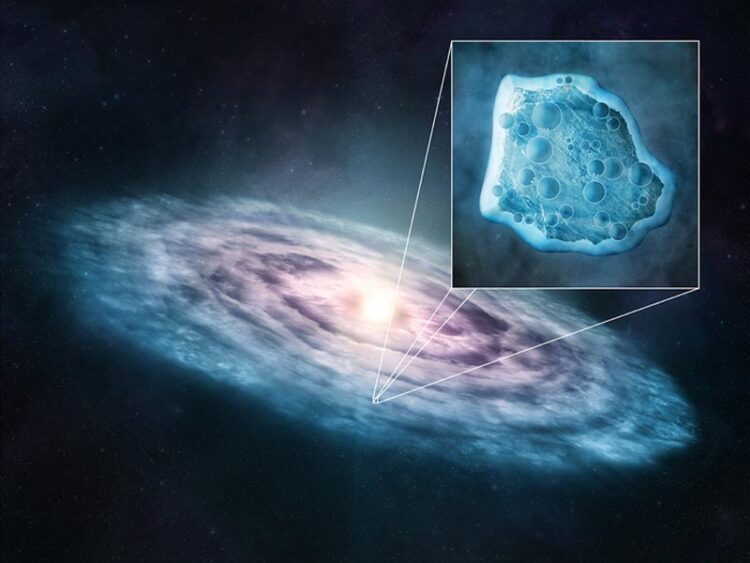Case solved: missing carbon monoxide was hiding in the ice

Artist’s illustration of a planetary disk, a region of dust and gas where planets form. The zoom-in insert displays carbon monoxide molecules in the ice phase.
Credit: M.Weiss/Center for Astrophysics | Harvard & Smithsonian
Astronomers frequently observe carbon monoxide in planetary nurseries. The compound is ultra-bright and extremely common in protoplanetary disks — regions of dust and gas where planets form around young stars — making it a prime target for scientists.
But for the last decade or so, something hasn’t been adding up when it comes to carbon monoxide observations, says Diana Powell, a NASA Hubble Fellow at the Center for Astrophysics | Harvard & Smithsonian.
A huge chunk of carbon monoxide is missing in all observations of disks, if astronomers’ current predictions of its abundance are correct.
Now, a new model — validated by observations with ALMA — has solved the mystery: carbon monoxide has been hiding in ice formations within the disks. The findings are described today in the journal Nature Astronomy.
“This may be one of the biggest unsolved problems in planet-forming disks,” says Powell, who led the study. “Depending on the system observed, carbon monoxide is three to 100 times less than it should be; it’s off by a really huge amount.”
And carbon monoxide inaccuracies could have huge implications for the field of astrochemistry.
“Carbon monoxide is essentially used to trace everything we know about disks — like mass, composition and temperature,” Powell explains. “This could mean many of our results for disks have been biased and uncertain because we don’t understand the compound well enough.”
Intrigued by the mystery, Powell put on her detective hat and leaned on her expertise in the physics behind phase changes — when matter morphs from one state to another, like a gas changing into a solid.
On a hunch, Powell made alterations to an astrophysical model that’s currently used to study clouds on exoplanets, or planets beyond our solar system.
“What’s really special about this model is that it has detailed physics for how ice forms on particles,” she explains. “So how ice nucleates onto small particles and then how it condenses. The model carefully tracks where ice is, on what particle it’s located on, how big the particles are, how small they are and then how they move around.”
Powell applied the adapted model to planetary disks, hoping to generate an in-depth understanding of how carbon monoxide evolves over time in planetary nurseries. To test the model’s validity, Powell then compared its output to real ALMA observations of carbon monoxide in four well-studied disks — TW Hya, HD 163296, DM Tau and IM Lup.
The results and models worked really well, Powell says.
The new model lined up with each of the observations, showing that the four disks weren’t actually missing carbon monoxide at all — it had just morphed into ice, which is currently undetectable with a telescope.
Radio observatories like ALMA allow astronomers to view carbon monoxide in space in its gas phase, but ice is much harder to detect with current technology, especially large formations of ice, Powell says.
The model shows that unlike previous thinking, carbon monoxide is forming on large particles of ice — especially after one million years. Prior to a million years, gaseous carbon monoxide is abundant and detectable in disks.
“This changes how we thought ice and gas were distributed in disks,” Powell says. “It also shows that detailed modelling like this is important to understand the fundamentals of these environments.”
Powell hopes her model can be further validated using observations with NASA’s Webb Telescope — which may be powerful enough to finally detect ice in disks, but that remains to be seen.
Powell, who loves phase changes and the complicated processes behind them, says she is in awe of their influence. “Small-scale ice formation physics influences disk formation and evolution — now that’s really cool.”
About the Center for Astrophysics | Harvard & Smithsonian
The Center for Astrophysics | Harvard & Smithsonian is a collaboration between Harvard and the Smithsonian designed to ask—and ultimately answer—humanity’s greatest unresolved questions about the nature of the universe. The Center for Astrophysics is headquartered in Cambridge, MA, with research facilities across the U.S. and around the world.
Journal: Nature Astronomy
DOI: 10.1038/s41550-022-01741-9
Article Title: Depletion of gaseous CO in protoplanetary disks by surface-energy-regulated ice formation
Article Publication Date: 22-Aug-2022
Media Contact
Nadia Whitehead
Center for Astrophysics | Harvard & Smithsonian
nadia.whitehead@cfa.harvard.edu
Office: 6177217371
All latest news from the category: Physics and Astronomy
This area deals with the fundamental laws and building blocks of nature and how they interact, the properties and the behavior of matter, and research into space and time and their structures.
innovations-report provides in-depth reports and articles on subjects such as astrophysics, laser technologies, nuclear, quantum, particle and solid-state physics, nanotechnologies, planetary research and findings (Mars, Venus) and developments related to the Hubble Telescope.
Newest articles

Pinpointing hydrogen isotopes in titanium hydride nanofilms
Although it is the smallest and lightest atom, hydrogen can have a big impact by infiltrating other materials and affecting their properties, such as superconductivity and metal-insulator-transitions. Now, researchers from…

A new way of entangling light and sound
For a wide variety of emerging quantum technologies, such as secure quantum communications and quantum computing, quantum entanglement is a prerequisite. Scientists at the Max-Planck-Institute for the Science of Light…

Telescope for NASA’s Roman Mission complete, delivered to Goddard
NASA’s Nancy Grace Roman Space Telescope is one giant step closer to unlocking the mysteries of the universe. The mission has now received its final major delivery: the Optical Telescope…



